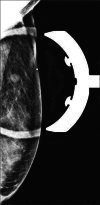Invasive mucinous carcinoma of the breast
- PMID: 23814397
- PMCID: PMC3684304
- DOI: 10.1080/08998280.2013.11928989
Invasive mucinous carcinoma of the breast
Abstract
Mucinous carcinoma of the breast is one of the rarer forms of intramammary cancer, often presenting as a lobulated, fairly well circumscribed mass on mammography, sonography, and gadolinium-enhanced magnetic resonance imaging. It accounts for 1% to 7% of all breast cancers and generally carries a better prognosis than other types of malignant breast cancers. Metastatic disease occurs at a lower frequency than in other types of invasive carcinoma. We present an atypical case of mucinous carcinoma in a woman who presented with a palpable intramammary lymph node metastasis from an unknown breast primary. Subsequent magnetic resonance imaging and percutaneous biopsy demonstrated histologic findings consistent with a mixed mucinous neoplasm with a micropapillary pattern.
Figures



References
-
- Cardenosa G, Doudna C, Eklund GW. Mucinous (colloid) breast cancer: clinical and mammographic findings in 10 patients. AJR Am J Roentgenol. 1994;162(5):1077–1079. - PubMed
-
- Lam WW, Chu WC, Tse GM, Ma TK. Sonographic appearance of mucinous carcinoma of the breast. AJR Am J Roentgenol. 2004;182(4):1069–1074. - PubMed
-
- Harvey JA. Unusual breast cancers: useful clues to expanding the differential diagnosis. Radiology. 2007;242(3):683–694. - PubMed
-
- Wilson TE, Helvie MA, Oberman HA, Joynt LK. Pure and mixed mucinous carcinoma of the breast: pathologic basis for differences in mammographic appearance. AJR Am J Roentgenol. 1995;165(2):285–289. - PubMed
LinkOut - more resources
Full Text Sources
Other Literature Sources
